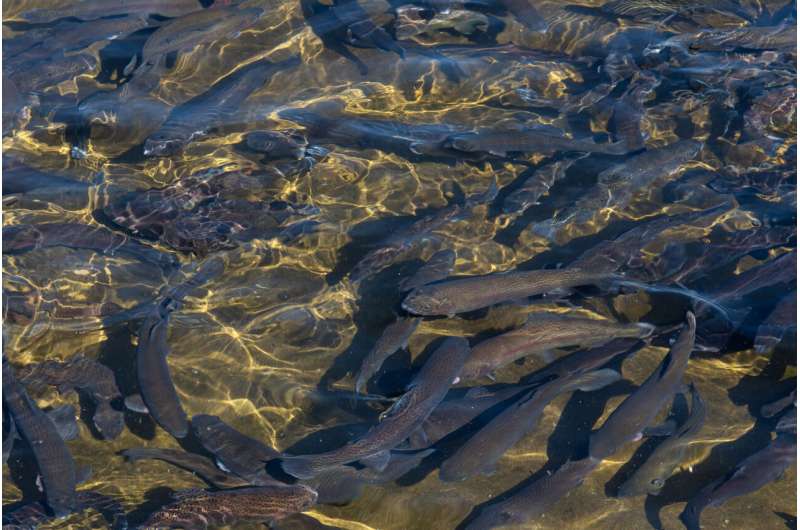Using genetics to support sustainable aquaculture: Results from 20 years of breeding rainbow trout

The world's oceans can no longer sustain the ever-rising demand for fish. Aquaculture offers an alternative approach—if production is sustainable and high quality. INRAE, the Aqualande group and its selective breeding company Les Sources de l'Avance, and the French Poultry and Aquaculture Breeders Technical Center (SYSAAF) reviewed data from 20 years of a rainbow trout breeding program conducted by the company. They compared the growth and nutrition needs of trout from this program with those of an unselected trout population.
Their findings, published in Aquaculture Reports, show that selected trout need 17% to 20% less feed to achieve the same growth as the unselected ones. As a result, the environmental impacts of fish farming can be reduced. A locally produced feed, made without fish oil, fishmeal or soy, was also tested on both groups of fish. The fish fed this "future" feed, which has similar nutritional characteristics, achieved similar growth performance. These unique results show that selective breeding and innovative feed sources can be effectively combined to make aquaculture more sustainable.
Between 1997 and 2019, the Aqualande group conducted a selective breeding program on 10 generations of rainbow trout, based on the principles established by INRAE and the SYSAAF. They also maintained unselected rainbow trout from the same original population. To determine the genetic gains in performance, INRAE, Aqualande and the SYSAAF participated in the collaborative European research program AquaImpact, during which they compared the growth, morphology, yield and filet lipid content of the selected and unselected groups of fish.
They also developed a sustainable feed based on INRAE research that was made without fish oil, fishmeal or soy to limit non-European imports. This feed was produced with ingredients from France and Europe, such as potato protein and microalgae. For 110 days, trout from both groups were given this feed, while others were fed a standard commercial feed containing fishmeal and fish oil.
The results show that trout from the selective breeding program needed 17% to 20% less feed than the unselected trout to achieve the same growth. Moreover, their filets had a higher lipid content, which improves their nutritional and taste profiles. Whether fed with the sustainable or the standard feed, trout from both groups grew at the same rates. Adding microalgae to the sustainable feed also enhanced the nutritional quality of the filets, which contained just as many Omega-3 long-chain fatty acids as filets from trout given the standard feed containing fish oil.
This study shows that selective breeding and the development of sustainable feeds are two important levers for reducing the environmental impact of farmed fish production and accelerating the transition to a more sustainable aquaculture.
More information: Marc Vandeputte et al, Realised genetic gains on growth, survival, feed conversion ratio and quality traits after ten generations of multi-trait selection in rainbow trout Oncorhynchus mykiss, fed a standard diet or a "future" fish-free and soy-free diet, Aquaculture Reports (2022). DOI: 10.1016/j.aqrep.2022.101363
Provided by INRAE - National Research Institute for Agriculture, Food and Environment
















